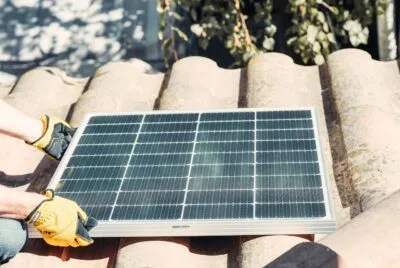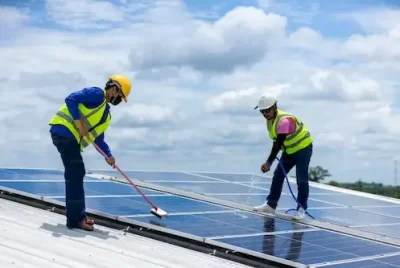Solar Panel Inspection: Three Easy Steps
We may earn a commission for purchases made using our links. See our disclosure to learn more.
Solar panels are, without a doubt, a financial outlay, but they are also a long-term investment in sustainability, clean energy, and diminished environmental impact. To get the most out of them, though, you need to take good care of them, just like any other investment. Maintaining fully functional solar panels requires regular solar panel inspection. According to experts, you should get your solar panels cleaned every six months. But have no fear; servicing solar panels is not as difficult as you would think.
In this piece, we’ll go over a simple 3-step technique that will help you maintain your solar panels and extend their useful lifespan. Okay, so let’s begin.
Step 1: Regular Solar Panel Inspection
Start by visually inspecting your solar panels periodically. While they are generally designed to withstand harsh weather conditions and other environmental factors, they aren’t invincible. Unforeseen damage can occur from falling debris, bird droppings, accumulation of dirt, or even initial installation mishaps.
Solar panel inspection visually at least once every few months. The temperature and other conditions in your area may affect how often you need to conduct these checks. If you happen to reside in a dusty area or one that has regular storms, for example, you may need to inspect your panels more frequently than someone who does not.
Keep in mind the following while you conduct these tests:
- Physical Damage: Look out for minor cracks can lead to efficiency losses or even total system failure if left unattended.
- Dirt and Debris: Check if there is any debris, like leaves or branches, or excessive dust or dirt accumulated on the surface of the panels.
- Bird Droppings: Bird droppings can harden and stick to the surface of the panels, blocking sunlight and reducing the panels’ efficiency.
- Shading: Make sure that no trees or other structures are casting a shadow on your solar panels, especially during peak sunlight hours.
Step 2: Regular Cleaning
After solar panel inspection comes regular cleaning. Solar panels work by allowing light into the solar cells. More light equates to more power generated. Sadly, a layer of dirt can form over your panels from the collection of dust, grime, bird droppings, and other debris, obstructing sunlight and diminishing their efficiency. A modest layer of dust can have a dramatic effect on the output of your solar panels.
Now that the importance of cleaning is clear, let’s break down how to keep your panels sparkling clean and efficient.
Natural Cleaning
Depending on where you live, Mother Nature might lend you a helping hand in the cleaning department. If your region frequently receives rainfall, it can act as a natural cleaning mechanism. Rainwater can wash away dust and loose debris, leaving your panels cleaner than before.
However, it’s worth mentioning that rainfall may not effectively clean more stubborn substances like hardened bird droppings or heavy dust accumulated during a dry spell. Moreover, if the rain in your area is often accompanied by strong winds, it may end up depositing more dirt and leaves on the panels.
So, while natural cleaning is an easy and eco-friendly cleaning method, it’s not a consistent or thorough approach. You’ll need to complement it with more active cleaning methods.
Hose Cleaning
A more proactive method to clean your solar panels is using a garden hose. This method is particularly effective during sunny days when the warm sunlight can help dry out the water, leaving minimal streaks on your panels.
When cleaning solar panels with a hose, it’s best to spray water uniformly across the panels from top to bottom. This ensures that the dirty water doesn’t leave streaks across the clean parts of the panels. Also, avoid using high-pressure water settings as this could potentially damage the panels or dislodge them if they’re not secured properly. This service is also included under the solar panel cleaning service.
Soap and Sponge
For stubborn dirt, a hose might not suffice, and you’ll need to step up your cleaning game. Prepare a bucket of warm water and mild detergent, and grab a soft sponge or a gentle squeegee. The warm water will help break down the stubborn grime, and the detergent will aid in its removal
When cleaning, gently scrub the surface of the panels using the sponge, following up with a rinse using clean water to remove any soap residue. Remember, the aim here is to clean the panels, not to scratch or damage them, so gentleness is key. Also, avoid abrasive cleaners or brushes that could leave scratches on your panels.
In some cases, your solar panel warranty might even require certain maintenance work to be carried out by professionals. So, it’s advisable to check your warranty details before embarking on a cleaning spree.
Step 3: Professional Maintenance and Checks
The final step is to engage professional maintenance and checks. While regular visual inspections and cleaning are something you can manage on your own, professional checks are essential to maintaining the overall health and efficiency of your solar panel system.
Professional solar panel cleaning service can perform comprehensive system checks, including the following:
Electrical Checks: They’ll ensure that all wiring and electrical connections are in order, the inverter is working correctly, and that the system is producing the correct output.
Structural Checks: They’ll inspect the mounting equipment for any signs of wear and tear or potential instability.
Efficiency Checks: They’ll ensure that the panels are performing at their optimal capacity and identify any performance issues.
Annual or bi-annual professional maintenance checks by solar panel maintenance companies can help identify and rectify issues that might not be evident to the untrained eye. This is especially important for larger solar installations, as they can suffer from “invisible” problems like potential induced degradation (PID) or micro-cracks, which only specialized equipment can detect.
In conclusion, the three steps to maintain your solar panels include regular solar panel inspection, cleaning, and professional maintenance checks. If you follow these steps, your solar panels will last longer and perform better for many years to come. Maintaining solar panels is essential to maximizing their output over the long term. If you treat your solar panels well, they’ll continue to provide you with clean, renewable power. If you found these tips helpful, read more on Solar Power Knowledge Hub!




